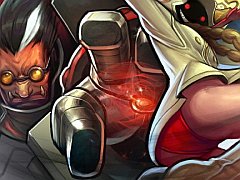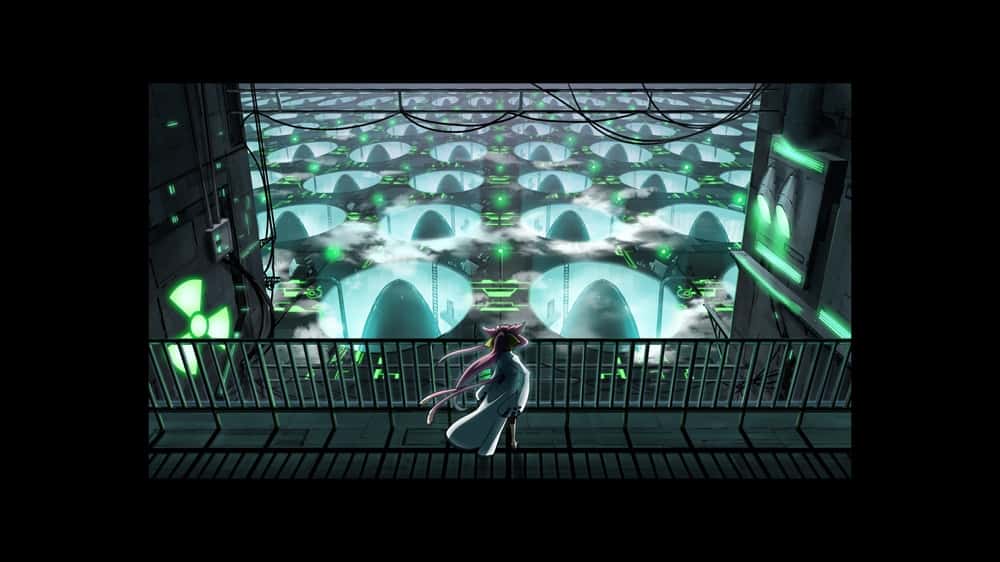You can trust VideoGamer. Our team of gaming experts spend hours testing and reviewing the latest games, to ensure you're reading the most comprehensive guide possible. Rest assured, all imagery and advice is unique and original. Check out how we test and review games here
“Boing! Boing! Boing! Your boobies are still the best!” she trills, in her high-pitched sing-song voice. “Hmmm, boobie lady, you seem kinda down! Everything but your boobies is sagging!”
It took me a while to realise it was happening, but over the past few days I’ve been slowly falling in love with Taokaka. It’s a bit odd, because to be perfectly honest, I’m not even that sure what she is. You can’t really see much of her face – just a pair of red eyes peering out from the darkness of her hoodie, and the occasional Cheshire cat grin. I mean the “cat” part literally, too: at first I was sure she was a human-feline hybrid, but on close inspection it appears that she’s just wearing an elaborate costume. Her ears and paws seem to be part of her clothing, but her tail is almost certainly real. At any rate, she certainly likes to say “meow” a lot – as in, “you’re making fun of meow”. Also, as the preceding quotation makes clear, she’s obsessed with other people’s tits.
According to a BlazBlue Wiki, Taokaka likes to wear skimpy red underwear beneath her coat. Then again, the other day some japester had changed her name to read “Lady Gaga”, so the guide may not be all that trustworthy. It says something about the nature of BlazBlue that it wouldn’t be entirely out of place if ol’ Poker Face herself turned up to take part in the scrap. After all, the rest of the cast includes a snobby vampiress; a scientist who’s turned into an inter-dimensional blob (with a facemask); and an anorexic young sprat in a top hat who fights alongside a mechanical doll, which may or may not contain the spirit of his sister. The game’s principle villain, Hazama, looks a bit like Michael Jackson in his Smooth Criminal garb… although he’s admittedly nowhere near as weird as Wacko in the latter stages of his metamorphosis.
It’s hardly unconventional for a fighting game to feature odd characters. Still, for anyone unfamiliar with Arc System Works’ previous output – which, I suspect, will include most people reading this review – BlazBlue: Continuum Shift is an intimidating prospect. It looks utterly beautiful, casting its detail-rich anime pugilists against obscenely intricate 3D backdrops, and yet its appearance will seem quite alien to anyone unacquainted with Japanese cartoon culture. And even if you’re not fazed by these rich visual flavours, the complexity of the one-on-one gameplay is immediately evident.
BlazBlue’s fights are swift, combo-focused affairs, with dozens of mechanics potentially affecting the action at any given time. There are counters, guard breaks and barriers, moves that can only be used when specific gauges have been filled, as well as Astral Heats – showboating finishing moves that can only be performed in a deciding round, when your opponent has less than a third of their health left, and when you when have still an unused Break Burst icon (and no, I’m not going to explain what they are). Naturally each character also has their own set of special moves – and as Tim Empey pointed in his review of the last game, it’s initially quite hard to separate these from the bread-and-butter ‘normals’, which are often equally strange.
Every fighting title worth its salt makes an effort to offer a decent spread of fighter types and diversity is an integral part of BlazBlue’s DNA. At the basic level, the game presents the player with four buttons. Three of these offer light, medium and heavy blows; the final button is used for Drive attacks, the nature of which varies hugely depending on your choice of fighter. Taokaka’s Drive attacks allow her to pounce about at incredible speed, allowing her to cross the screen swiftly or to play mind games with her opponent. Ragna the Bloodedge – a sword-wielding emo-type who serves as the series’ posterboy – can use his Drive to drain energy from his rivals, allowing him to stay in the fight that little while longer.
While some Drives offer familiar gameplay tools – Jin’s moves can let him freeze his opponent, for example – others open up specialities that make for wildly different playstyles. Arakune, the aforementioned scientist-turned-blob, has to use his Drive to build up a curse meter, which is unique to him; once the gauge has been filled via successful Drive attacks, each of his normals will cause an insect to fly across the screen, damaging the other fighter if it hits them. In his non-curse state he’s a relative weakling; with the gauge full, he’s an absolute terror – unleashing a torrent of bugs that can juggle and combo your poor rival in conjunction with the other moves in his arsenal.
While this assortment of mechanics and playstyles is undoubtedly quite scary, the upshot is that there’s a huge amount of tactical choice for players who are prepared to put the hours in to learn the trade. And for all its daunting qualities, Continuum Shift actually makes a concentrated effort to teach newcomers the ropes. Every aspect of the game is carefully explained in step-by-step detail in the commendably thorough Tutorial mode, from the most basic of basic rules, right up to the finer aspects of high-end play. These lessons are narrated in amusingly condescending fashion by Rachel Alucard (the posh vampire girl I mentioned earlier), and they’re genuinely useful – explaining common fighter game terminology like cancelling, zoning, and wake-up play. If you were going to teach your Nan how to be the next Daigo Umehara, you could do worse than to sort out with a copy of BlazBlue: Continuum Shift.
Street Fighter IV may have succeeded in drawing a new generation back to fighting games, but Capcom has never made this level of effort in terms of accommodating newcomers. There’s a Beginner setting that allows absolute fledglings (or carefully bribed younger siblings) to perform moves and combos by mashing the buttons, but if you’re going to play the game, you should really put the hours in and follow the guides; the tutorials even include a quick strategic overview of each character’s strengths and weaknesses, as well as the moves and combos that should make up your basic arsenal. This is the kind of valuable guidance that’s long been missing from Capcom’s proudly hardcore titles – and from the genre in general – so it’s somewhat ironic that the reforms are being pioneered by a series that most newcomers will be too scared to approach.
I should acknowledge at this point that BlazBlue: Continuum Shift is really only a semi-sequel to BlazBlue: Calamity Trigger, which was released in Europe earlier this year. If you’re a veteran of the franchise you’ll know this already, and you’re probably only still reading this so that you can laugh at my noobish attempts to sound authoritative (hey, I’m trying). Continuum Shift has been out for a while now, and while Arc System Works has supposedly tried to make the game more balanced than its predecessor, the prevailing opinion among the fans is that it has just shifted the scales in a different direction. Rachel has been heavily nerfed, Bang is now godly, and two of the three new characters – Hazama and Tsubaki – aren’t far behind. The third addition, Lambda, is a watered down version of v-13, the hard-as-nails boss from Calamity Trigger.
I won’t pretend to have an expert, intimate feeling for the game’s balance. To my confessedly-amateurish eye, it does seem that some of the characters get an easier ride than others, but not in a way that affects the game too severely – certainly not for lower-end players, at any rate. The hardcore will no doubt have their own opinions, and as I’ve already said, they’ll most likely have formed them weeks ago. For what it’s worth, I’ve still seen a fair few Rachels absolutely destroying their opposition online, so she can’t have been neutered to the point where she’s unusable.
On that note, I’ll add that the netcode seems to be very reliable. It can take a few goes to find a room that’s free, but there are plenty of people playing on Xbox LIVE, and once you’re in a room, the connections seem commendably stable. Naturally, the people who are playing are generally very good – so don’t go expecting an easy ascent through the ranks if you’re just starting out.
Aside from network play and standard Arcade mode, Continuum Shift offers an expansive Story mode with threads for each of the main characters, featuring largely-static cutscenes that can go on for ages at times. I won’t even begin to touch on the plot, as it’s hugely complicated and very, very strange. Still, if you like the game you might just get into it, and even if you don’t it’ll probably give you a laugh. Each character’s story has multiple endings and can unlock a swathe of extra content to peruse in the Gallery. Other distractions include a Challenge mode (for learning combos), a Score Attack mode (for showing off) and Legion mode – an oddity that mixes Risk-style board game antics with traditional Survival play. It’s not that great, truth be told, but it’s worth a look if you’re curious. The main game is so sweet – so varied in style, so complex and rewarding, and so gosh-darned pretty – that it really doesn’t need all these optional extras. Still, it’s certainly nice to have them.
If you’re one of the many people who’s been exploring the fighting genre for the first time with SFIV/SSFIV, I thoroughly recommend that you give BlazBlue: Continuum Shift a whirl. It’ll teach you things, broaden your horizons, and give you a damn good time; think of it as the Mrs Robinson to your brawling Benjamin Braddock. As Taokaka might say, meow can you resist?
BlazBlue: Continuum Shift
- Platform(s): PlayStation 3, Xbox 360
- Genre(s): Arcade, Beat 'em Up, Fighting

/https://oimg.videogamer.com/images/adc5/bbcs_4.jpg)
/https://oimg.videogamer.com/images/ae55/bbcs_7.jpg)






